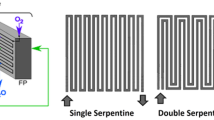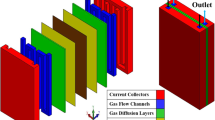Abstract
The present study is aimed at demonstrating the efficacy of enhanced cross-flow split serpentine flow field (ECSSFF) over the single serpentine flow field (SSFF) for a polymer electrolyte membrane fuel cell of 55 cm2 active area using three-dimensional, multiphase, full-scale CFD simulations. For the present study, pure air and hydrogen are used as reactants on cathode and anode side, respectively. The effect of rib width-to-channel width ratio on the cell performance for the two flow field designs is studied. The power output of the three-channeled ECSSFF is studied and compared with the performance of SSFF at different operating temperatures and pressures. The performance displayed by ECSSFF design is on par with that of SSFF design with almost 30 times lesser pressure drop. ECSSFF has exhibited superior performance in terms of offering high currents and low pressure drops compared to SSFF.












Similar content being viewed by others

Abbreviations
- BCGSTAB:
-
Bi-conjugate gradient stabilize method
- BP:
-
Bipolar plate
- CC:
-
Current collectors
- CL:
-
Catalyst layer
- CW:
-
Channel width
- ECSSFF:
-
Enhanced cross-flow split serpentine flow field
- GDL:
-
Gas diffusion layer
- GFC:
-
Gas flow channel
- LBM:
-
Lattice–Boltzmann method
- MEA:
-
Membrane electrode assembly
- MPL:
-
Membrane porous layer
- PEM:
-
Proton exchange membrane
- PEMFC:
-
Proton exchange membrane fuel cell
- RH:
-
Relative humidity
- RW:
-
Rib width
- SSFF:
-
Single serpentine flow field
- TSFF:
-
Triple serpentine flow field
References
Alaswad, A.; Baroutaji, A.; Achour, H.; Carton, J.; Al Makky, A.; Olabi, A.G.: Developments in fuel cell technologies in the transport sector. Int. J. Hydrog. Energy 41, 16499–16508 (2016). https://doi.org/10.1016/j.ijhydene.2016.03.164
Grigoriev, S.A.; Kalinnikov, A.A.; Kuleshov, N.V.; Millet, P.: Numerical optimization of bipolar plates and gas diffusion electrodes for PBI-based PEM fuel cells. Int. J. Hydrog. Energy 38, 8557–8567 (2013). https://doi.org/10.1016/j.ijhydene.2012.12.021
Rostami, L.; Nejad, P.M.G.; Vatani, A.: A numerical investigation of serpentine flow channel with different bend sizes in polymer electrolyte membrane fuel cells. Energy 97, 400–410 (2016). https://doi.org/10.1016/j.energy.2015.10.132
Tiss, F.; Chouikh, R.; Guizani, A.: A numerical investigation of the effects of membrane swelling in polymer electrolyte fuel cells. Energy Convers. Manag. 67, 318–324 (2013). https://doi.org/10.1016/j.enconman.2012.12.006
Kerkoub, Y.; Benzaoui, A.; Haddad, F.; Ziari, Y.K.: Channel to rib width ratio influence with various flow field designs on performance of PEM fuel cell. Energy Convers. Manag. 174, 260–275 (2018). https://doi.org/10.1016/j.enconman.2018.08.041
Ghanbarian, A.; Kermani, M.J.; Scholta, J.; Abdollahzadeh, M.: Polymer electrolyte membrane fuel cell flow field design criteria—application to parallel serpentine flow patterns. Energy Convers. Manag. 166, 281–296 (2018). https://doi.org/10.1016/j.enconman.2018.04.018
Akbari, M.H.; Rismanchi, B.: Numerical investigation of flow field configuration and contact resistance for PEM fuel cell performance. Renew. Energy 33, 1775–1783 (2008). https://doi.org/10.1016/j.renene.2007.10.009
Al-Baghdadi, M.A.R.S.; Al-Janabi, H.A.K.S.: Parametric and optimization study of a PEM fuel cell performance using three-dimensional computational fluid dynamics model. Renew. Energy 32, 1077–1101 (2007). https://doi.org/10.1016/j.renene.2006.04.018
Cooper, N.J.; Santamaria, A.D.; Becton, M.K.; Park, J.W.: Investigation of the performance improvement in decreasing aspect ratio interdigitated flow field PEMFCs. Energy Convers. Manag. 136, 307–317 (2017). https://doi.org/10.1016/j.enconman.2017.01.005
Zehtabiyan-Rezaie, N.; Arefian, A.; Kermani, M.J.; Noughabi, A.K.; Abdollahzadeh, M.: Effect of flow field with converging and diverging channels on proton exchange membrane fuel cell performance. Energy Convers. Manag. 152, 31–44 (2017). https://doi.org/10.1016/j.enconman.2017.09.009
Molaeimanesh, G.R.; Shojaeefard, M.H.; Moqaddari, M.R.: Effects of electrode compression on the water droplet removal from proton exchange membrane fuel cells. Korean J. Chem. Eng. 36, 136–145 (2019). https://doi.org/10.1007/s11814-018-0157-y
Lü, W.; Liu, Z.; Wang, C.; Mao, Z.; Zhang, M.: Proton exchange membrane fuel cell with humidifying zone. Chin. J. Chem. Eng. 18, 856–862 (2010). https://doi.org/10.1016/S1004-9541(09)60139-7
Barati, S.; Ghazi, M.M.; Khoshandam, B.: Study of effective parameters for the polarization characterization of PEMFCs sensitivity analysis and numerical simulation. Korean J. Chem. Eng. 36, 146–156 (2019). https://doi.org/10.1007/s11814-018-0178-6
Levitas, V.I.; Roy, A.M.; Preston, D.L.: Multiple twinning and variant-variant transformations in martensite: phase-field approach. Phys. Rev. B 88, 054113 (2013). https://doi.org/10.1103/physrevb.88.054113
Levitas, V.I.; Roy, A.M.: Multiphase phase field theory for temperature- and stress-induced phase transformations. Phys. Rev. B 91, 174109 (2015). https://doi.org/10.1103/physrevb.91.174109
Levitas, V.I.; Roy, A.M.: Multiphase phase field theory for temperature-induced phase transformations: formulation and application to interfacial phases. Acta Mater. 105, 244–257 (2016). https://doi.org/10.1016/j.actamat.2015.12.013
Park, S.; Popov, B.N.: Effect of membrane-electrode-assembly configuration on proton exchange membrane fuel cell performance. Korean J. Chem. Eng. 31, 1384–1388 (2014). https://doi.org/10.1007/s11814-014-0037-z
Badduri, S.R.; Srinivasulu, G.N.; Rao, S.S.: Influence of bio-inspired flow channel designs on the performance of a PEM fuel cell. Chin. J. Chem. Eng. 28, 824–831 (2019). https://doi.org/10.1016/j.cjche.2019.07.010
Arvay, A.; French, J.; Wang, J.C.; Peng, X.H.; Kannan, A.M.: Nature inspired flow field designs for proton exchange membrane fuel cell. Int. J. Hydrog. Energy 38, 3717–3726 (2013). https://doi.org/10.1016/j.ijhydene.2012.12.149
Suresh, P.V.; Jayanti, S.; Deshpande, A.P.; Haridoss, P.: An improved serpentine flow field with enhanced cross-flow for fuel cell applications. Int. J. Hydrog. Energy 36, 6067–6072 (2011). https://doi.org/10.1016/j.ijhydene.2011.01.147
Abdulla, S.; Patnaikuni, V.S.: Detailed analysis of polymer electrolyte membrane fuel cell with enhanced cross-flow split serpentine flow field design. Int. J. Energy Res. 43, 2806–2820 (2019). https://doi.org/10.1002/er.4368
Abdulla, S.; Patnaikuni, V.S.: Performance evaluation of enhanced cross flow split serpentine flow field design for higher active area PEM fuel cells. Int. J. Hydrog. Energy (2020). https://doi.org/10.1016/j.ijhydene.2020.01.199
Arvay, A.; Ahmed, A.; Peng, X.H.; Kannan, A.M.: Convergence criteria establishment for 3D simulation of proton exchange membrane fuel cell. Int. J. Hydrog. Energy 37, 2482–2489 (2012). https://doi.org/10.1016/j.ijhydene.2011.11.005
Zinko, T.; Pianko-Oprych, P.; Jaworski, Z.: Three-dimensional computational fluid dynamics modelling of a proton exchange membrane fuel cell with a serpentine micro-channel design. Chem. Process. Eng. 39, 143–154 (2018). https://doi.org/10.24425/119105
Ansys Inc: ANSYS Fluent Fuel Cell Modules Manual, Release 15.0. 15317, 2019 (2013)
Ozden, E.; Tari, I.: Proton exchange membrane fuel cell degradation: a parametric analysis using computational fluid dynamics. J. Power Sources 304, 64–73 (2016). https://doi.org/10.1016/j.jpowsour.2015.11.042
Chowdhury, M.Z.; Timurkutluk, B.: Transport phenomena of convergent and divergent serpentine flow fields for PEMFC. Energy 161, 104–117 (2018). https://doi.org/10.1016/j.energy.2018.07.143
Limjeerajarus, N.; Charoen-amornkitt, P.: Effect of different flow field designs and number of channels on performance of a small PEFC. Int. J. Hydrog. Energy 40, 7144–7158 (2015). https://doi.org/10.1016/j.ijhydene.2015.04.007
Chowdhury, M.Z.; Genc, O.; Toros, S.: Numerical optimization of channel to land width ratio for PEM fuel cell. Int. J. Hydrog. Energy 43, 10798–10809 (2018). https://doi.org/10.1016/j.ijhydene.2017.12.149
Carcadea, E.; Varlam, M.; Ingham, D.B.; Ismail, M.S.; Patularu, L.; Marinoiu, A.; Schitea, D.: The effects of cathode flow channel size and operating conditions on PEM fuel performance: a CFD modelling study and experimental demonstration. Int. J. Energy Res. 42, 1–16 (2018). https://doi.org/10.1002/er.4068
Heidary, H.; Kermani, M.J.; Advani, S.G.; Prasad, A.K.: Experimental investigation of in-line and staggered blockages in parallel flowfield channels of PEM fuel cells. Int. J. Hydrog. Energy 41, 6885–6893 (2016). https://doi.org/10.1016/j.ijhydene.2016.03.028
Liu, X.; Guo, H.; Ye, F.; Ma, C.F.: Flow dynamic characteristics in flow field of proton exchange membrane fuel cells. Int. J. Hydrog. Energy 33, 1040–1051 (2008). https://doi.org/10.1016/j.ijhydene.2007.11.018
Wang, X.-D.; Duan, Y.-Y.; Yan, W.-M.; Weng, F.-B.: Effect of humidity of reactants on the cell performance of PEM fuel cells with parallel and interdigitated flow field designs. J. Power Sources 176, 247–258 (2008). https://doi.org/10.1016/j.jpowsour.2007.10.065
Kahveci, E.E.; Taymaz, I.: Assessment of single-serpentine PEM fuel cell model developed by computational fluid dynamics. Fuel 217, 51–58 (2018). https://doi.org/10.1016/j.fuel.2017.12.073
Yuan, W.; Tang, Y.; Pan, M.; Li, Z.; Tang, B.: Model prediction of effects of operating parameters on proton exchange membrane fuel cell performance. Renew. Energy 35, 656–666 (2010). https://doi.org/10.1016/j.renene.2009.08.017
Author information
Authors and Affiliations
Corresponding author
Rights and permissions
About this article
Cite this article
Abdulla, S., Seepana, M.M. & Patnaikuni, V.S. Performance Comparison of PEM Fuel Cell with Enhanced Cross-Flow Split Serpentine and Single Serpentine Flow Field Designs. Arab J Sci Eng 45, 7691–7703 (2020). https://doi.org/10.1007/s13369-020-04803-0
Received:
Accepted:
Published:
Issue Date:
DOI: https://doi.org/10.1007/s13369-020-04803-0



